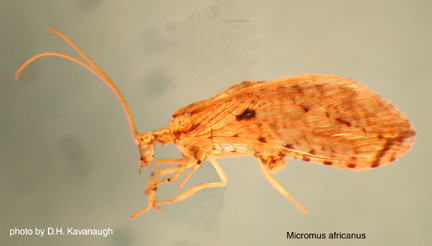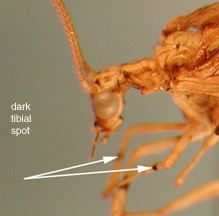|
||||
NOTES ON THE HEMEROBIIDAE (BROWN LACEWINGS) OF MADAGASCAR AND ADJACENT ISLANDS

The references mentioned in this annotated list are fully cited on the NeuroWeb (http://entowww.tamu.edu/research/neuropterida/neuroweb.html)
HEMEROBIIDAE
Hemerobius binigripunctatus Fraser, 1957
Type Depository: MNHN, Paris (originally Institut de Recherche Scientifique, Antananarivo).
Type Locality: none designated in original description.
Geographical Distribution: Ohm & Hölzel (1997) indicate a distribution for this species on the Mascarenes Islands of REUNION and MAURITIUS. Fraser’s (1957) original description mentioned the Reunion Island localities of Bebour, January 1955; Kerveguen Pond; Rempart de Belouve; Belouve Plateau; Hellbourg; and Cafres Plain, 27 January 1955 (all collected by R. Paulian). Monserrat (1991) mentions this species from the following localities: Mauritius, Plaine Champagne, 750 m, 28 November 1990, H. & L. Hölzel, 1 female (Monserrat Collection); 4 December 1990, H. & L. Hölzel, 1 male (Monserrat Collection); Reunion Island, Rempart de Belouve, January 1955, R. Paulian, 2 females (BMNH). Ohm & Hölzel (1997) mention seven additional specimens from Mauritius in the same 1990 series.
Notes: There was no indication of a type specimen in the original description. Apparently no lectotype has ever been designated. There has been difficulty finding types of other Fraser species and this one also may be lost. Monserrat (1991) mentions two female paratypes in the BMNH, London. Monserrat (1991) also provides good illustrations of the wings and male and female genitalia.
Hemerobius nairobicus Navás, 1910
= Hemerobius comorensis Krueger, 1922
Type Depository: MNHN, Paris
Type Locality: Kenya: Nairobi, 1 male.
Geographical Distribution: Tjeder (1961) indicates that this species is found in KENYA, UGANDA, SOUTH AFRICA, and ZIMBABWE. Monserrat (1991) indicates its presence on the COMORO ISLANDS, TANZANIA, and RUANDA.
Notes: Tjeder (1961) presents good illustrations of male and female genitalia and photos of the wings.
The synonymy of H. comorensis with H. nairobicus was suggested by Monserrat (1991).


Micromus africanus Weele, 1910
= Micromus lanceolatus Navás, 1910
= Stenomus nesaeus Navás, 1922
= Micromus ludicrus Navás, 1933
= Eumicromus maculipes Fraser, 1957
Type Depository: Riksmuseum, Stockholm, Sweden.
Type Locality: Tanzania: Kilimanjaro, Kibonoto, 1300-1900 m, September 1905, Y. Sjostedt.
Geographical Distribution: Tjeder (1961) records this species from ETHIOPIA, UGANDA, KENYA, TANZANIA, ZIMBABWE, and SOUTH AFRICA. Fraser (1957) described this species, under the name Eumicromus maculipes from REUNION ISLAND. Ohm & Hölzel (1997) mention its presence on MAURITIUS and mainland MADAGASCAR. They also cite known records from Reunion. Navás (1934) mentions two females under the name Micromus ludicrus from Madagascar: Tsinjoarivo, 21 February 1932, A. Seyrig in the Paris Museum. Additional records are: Madagascar: Montagne d'Ambre, 12 August 1992, Vincent & B. Roth, 2 specimens (CAS); Fiananrantsoa Prov., Ranomafana National Park, Talatakely and Vohiparara, April 1998, N.D. Penny, 20 specimens (CAS).
Notes: Tjeder (1961) has good illustrations of wings and male and female genitalia. The small dorsal projection of the male arcessus seems to be distinctive and characteristic. This was the only species from 20 specimens of Micromus collected at Ranomafana National Park during April 1998. It was infrequently collected on fruiting Asian guava trees in short secondary forest. Tjeder (1961) established the synonymy of M. ludicrus with M. africanus and this synonymy was confirmed by Monserrat (1990a). Monserrat (1990b) indicates that M. lanceolatus is a synonym of M. africanus. Monserrat (1992) indicates that M. maculipes is also a probable synonym of M. africanus although the original type cannot be located. Oswald (1993) synonymized Stenomus nesaeus with M. africanus.
Micromus plagatus Navás, 1934
= Micromus zonarius Navás, 1936
= Eumicromus fuscostriatus Fraser, 1951
= Eumicromus malgassicus Fraser, 1951
Type Depository: MNHN, Paris
Type Locality: Madagascar, Kalambatrita, February 1933, A. Seyrig.
Geographical Distribution: Monserrat (1992) indicated that this species is known from MADAGASCAR and MAURITIUS. In this publication he lists the following localities from Mauritius: Plaine Champagne, 28 November 1990, H. & L. Hölzel, 2 males; 6 December 1990, H. & L. Hölzel, 1 male, 1 female. The type of E. fuscostriatus is from Madagascar: Tsimbazaza, 20 July 1948, R. Paulian, 1 female. The type of E. malgassicus is from Madagascar: Tanan. [Antananarivo], July 1947, R. Paulian, 1 male, 1 female. The type of M. zonarius is from Madagascar: Bekily in the southern part of the island, May 1934, A. Seyrig, 1 male. Ohm & Hölzel (1998) list this species from the COMOROS ISLANDS: Forest W. Vahibe, 25 November 1993, 1 female, as well as MAYOTTE and REUNION ISLAND.
Notes: The synonymy of M. zonarius with M. plagatus is that of Monserrat (1990b). The last two listed synonymies are those of Monserrat (1992).
Micromus timidus Hagen, 1853
= Micromus insularis Hagen, 1886
= Micromus benardi Navás, 1912
= Micromus alternans Navás, 1922
= Micromus insulanus Navás, 1925
= Micromus philippinus Navás, 1926
= Eumicromus multinervosa Fraser, 1955
= Eumicromus parallelus Fraser, 1957
Type Depository:
Type Locality:
Geographical Distribution: This species appears to be the most widely distributed of all hemerobiids, and perhaps all Neuroptera. It is found throughout tropical Africa, Asia, Indonesia, Australia, and many of the Pacific Islands (Tjeder, 1961). Monserrat (1992) provides records for IVORY COAST and ZAIRE. Additional country records for COMORO ISLANDS and SEYCHELLES ISLANDS are to be found in Ohm & Hölzel (1997). Ohm & Hölzel (1998) further record this species from SENEGAL and ETHIOPIA.
Notes: Tjeder (1961) provides good illustrations of male genitalia. Monserrat (1990b) synonymized M. benardi, M. alternans, M. insulanus, and M. philippinus with M. timidus. Monserrat (1992) synonymized M. insularis and E. multinervosa with M timidus. The final synonymy is that of Ohm & Hölzel (1997).
Notiobiella nitidula Navás, 1910
Type Depository: MNHN, Paris
Type Locality: British East Africa, Boura (Wa-Taita), March 1904, Ch. Alluaud, 1 male.
Geographical Distribution: Ohm & Hölzel (1998) indicate that this species is known from SENEGAL, KENYA, SOUTH AFRICA, ANGOLA, CAPE VERDE ISLANDS, COMORO ISLANDS and MADAGASCAR. From the Comoro Islands, the single known specimen was collected at: S outskirts of Mamoudzou, terrace of hotel, at lamps, 21 November 1994, 1 female.
Notes: Monserrat (1984) provides a redescription of this species, as well as providing illustrations of the wings and male genitalia. He also designated the Paris Museum specimen as lectotype from the original type series.
Notiobiella peterseni Banks, 1932
Type Depository: MCZ, Cambridge, MA, USA
Type Locality: Madagascar: Tananarive [Antananarivo], Challiat.
Geographical Distribution: In addition to the type from MADAGASCAR, Ohm & Hölzel (1998) indicate that this species is also found on the COMORO ISLANDS and RUANDA. The Comoro Islands material is from: Forest W Vahibe, 25 November 1993, 2 males; 17 November 1994, 1 male; SW Bandrele, 16 November 1994, 1 female. Madagascar: Montagne d'Ambre, 12 August 1992, Vincent & B. Roth, 1 specimen (CAS); Fianarantsoa, Ranomafana National Park, Talatakely (21, 15’S, 47, 25’E), 900 m, 8 April 1998, N.D. Penny, 1 female (CAS), beating in secondary tropical forest; Ranomafana National Park (21, 15’S, 47, 25’E), 1100 m, 1 November 1988, Warren Steiner, 1 female (USNM).
Notes: Monserrat (1984) provides a redescription of this species, as well as illustration of the wings. Unfortunately, the abdomen has been lost and no illustrations are currently available of the male genitalia, making identification more difficult. The wing drawings appear to show that this species has somewhat more pigmentation at the vein forks and no pale brown band across the radial sector area in contrast to N. nitidula. The radial sector forks of the hindwing of N. peterseni also appear to be longer. However, these differences are potentially variable and until the male genitalia of N. peterseni can be studied identifications will necessarily be somewhat suspect. This species is bright green when alive, but slowly fades to pale brown after death.
Sympherobius sp. #1
Geographical Distribution: Madagascar: Toliara Prov., Ifaty, 22 km N Toliara (23, 11’S, 43, 37’E), 30 m, 19 April 1998, M.E. Irwin & E.I. Schlinger, 1 female, Malaise trap in spiny forest (CAS).
Notes: This genus has not previously been reported from Madagascar.
Wesmaelius praenubilus (Fraser, 1951)
Type Depository: MNHN, Paris
Type Locality: Madagascar, Tananarive [Antananarivo], Tsimbazaza, R. Paulian, 1 female.
Geographical Distribution: Currently known only from the type female.
Notes: Most of the Fraser types have been lost. The original description mentions the type and a pair of mounted wings. The original description includes illustrations of the wings. As far as I know, no male specimens of this species have ever been collected.
Last Update 6 April 2000




